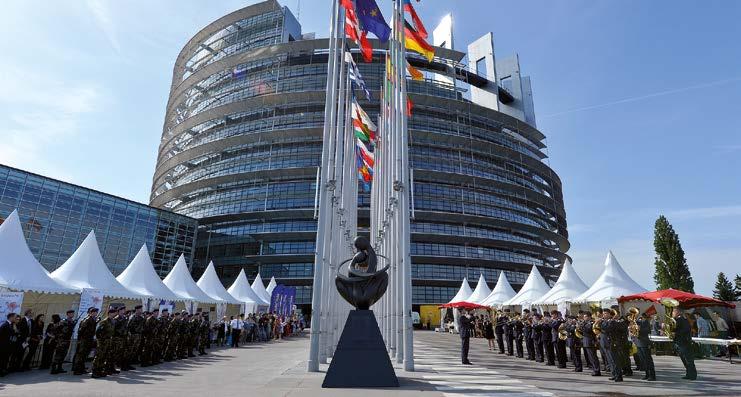MAIN TOPIC: Migration and refugees
The Aquarius’ daily work to save people’s lives
photo: Maud Veith
SOS MEDITERRANEE’s mission is to restore humantity at sea and on land
Interview with Verena Papke, Director General, SOS MEDITERRANEE Germany, Berlin
I
n the last 4 years at least 15,000 people have died crossing the Mediterranean Sea. 80% of migrants attempting this dangerous journey on small boats flee the chaos in Libya in the hope of reaching the coasts of Italy. The rescue ship “Aquarius” – operated since February 2016 by SOS MEDITERRANEE, together with Médecins sans Frontières – has saved close to 30,000 lives in more than 230 rescue missions in the Central Mediterranean. Having become a matter of controversy in the European discussion on how the situation in the Mediterranean could be managed, the Aquarius is currently blocked in the harbor of Marseille after the Panama Maritime Authorities revoked the registration of the ship. We wanted to learn more about this NGO and the people behind it. Verena Papke, General Director of SOS MEDITERRANEE Germany gave us insights of the team’s daily work and battle. The European: Ms Papke, you are the Director General of SOS MEDITERRANEE Germany, could you please briefly present your maritime and humanitarian organisation to our readers? Verena Papke: Let me start at the beginning: SOS MEDITERRANEE was founded in 2015 by a group of professional European seafarers and humanitarians in response to the humanitarian tragedy unfolding in the Central Mediterranean. At that time, the Italian search and rescue programme “Mare Nostrum” was terminated after European Member States declined to support it, and the result was an increase of deaths at sea. As seafarers
and humanitarians, but also as European citizens, we could not stand by and watch men, women and children drown. We chartered a ship, the “Aquarius”, 77m long and with a rescue capacity of more than 500 people – and launched a search-andrescue mission in international waters off the Libyan coast. The European: Could you tell us more about the people working aboard the Aquarius? Verena Papke: Three teams work aboard the Aquarius: the marine crew (Captain, engineers etc.), the SOS MEDITERRANEE rescue team made up of professionals with backgrounds in navigation, lifeguarding and emergency response, and the medical team of Médecins Sans Frontières (MSF) who is a partner of SOS MEDITERRANEE since 2015. The search-and-rescue coordinator, who usually has a professional background in navigation, is responsible for the coordination of a rescue. S/he coordinates with all team members on the Aquarius and is in constant contact with the responsible maritime authorities, to receive instructions and to keep them updated about our on-going operations. The European: Could you describe in more detail what normally happens during a rescue mission? Verena Papke: Usually, the Aquarius either receives a distress call from the relevant maritime authorities or our rescue team spots a boat in distress. At sea, the rescue team is on watch 24 hours a day, taking shifts, and monitoring the horizon with binoculars, looking for boats in distress. The rubber boats are so small that they can barely be spotted on the boat’s radar. Once we are close to a boat in distress, we launch our smaller rescue boats, approach the boat in distress, establish first contact
27

















